
34 minute read
NEWS KIOSKO
"BLACK SABBATH DEBUT, FIFTY YEARS LATER" PÁGINA 12 ARGENTINA
This profile about the legendary band is a tribute to their journey and legacy, while allowing us to see why it transcended in time. "It was necessary to give a maceration time at the end of the flower-power dream, of course. [...] There was no going back now: fear was the key to success". ste perfil sobre la legendaria banda es un homenaje a su recorrido y legado, al tiempo que nos permite ver por qué trascendió en el tiempo. "Había que darle un tiempo de maceración al final del sueño “flower-power”, claro. [...] Ya no había marcha atrás: el miedo era la clave del éxito".
Advertisement
https://www.pagina12.com.ar/247148-el-debut-de-black-sabbath-cincuenta-anos-despues
"JUANITA SMILES LIKE SHE'S NOT A SURVIVOR" LA VIDA DE NOS VENEZUELA
"La vida de nos" is a media of narrative journalism about stories of resilience. Juanita's story describes her strength in the face of the extinction of the leprosy in which she lived with her great love and which she has seen diminish to the point of going from having 100 inmates to 5, including her. "There is silence. There is silence and that is why any sound, however small, sounds amplified. Like an echo. Long corridors connect with eight dozen empty rooms, like open shells." "La vida de nos" es un medio de periodismo narrativo sobre historias de resiliencia. La de Juanita cuenta su fortaleza frente a la extinción del leprocomio en que vivió con su gran amor y que ha visto menguar hasta el punto de pasar de tener 100 internos a 5, incluyéndola a ella. "Hay silencio. Hay silencio y por eso cualquier sonido, por pequeño que sea, suena amplificado. Como un eco. Largos pasillos conectan con ocho decenas de habitaciones vacías, cual cascarones abiertos".

https://www.lavidadenos.com/juanita-sonrie-como-si-no-fuera-una-sobreviviente/
CIPER CHILE

The CIPER made a careful investigation controlling the control that the Chilean armed forces make over the possible consumption of drugs within their ranks and how strict their vigilance is. "Between 2015 and 2019 more than 1,000 drug tests applied to military and police personnel tested positive for marijuana and cocaine. Although this is a marginal figure for the total number of tests carried out, CIPER found a number of irregularities". El CIPER hizo una cuidadosa investigación fiscalizando el control que las fuerzas armadas chilenas hacen sobre el posible consumo de drogas al interior de sus filas y qué tan estricto es su vigilancia. "Entre 2015 y 2019 más de 1.000 test de drogas aplicados a personal militar y policial dieron positivos para marihuana y cocaína. A pesar de que se trata de una cifra marginal para el total de exámenes realizados, CIPER halló una serie de irregularidades".
https://ciperchile.cl/2020/02/12/radiografia-al-consumo-de-drogas-en-las-fuerzas-armadas-y-las-policias/
"Calombolo, Survival of a Village" is a photo story about the salt harvest in Angola, where the extensive white fields, which seem to be snow-covered with so much salt, are contrasted with the bright and dark skins of the women who work in them. "CALOMBOLO, SURVIVAL OF A VILLAGE" PERIODISMO DE BARRIO CUBA
"Calombolo, sobrevivencia de un pueblo" es un fotoreportaje sobre la cosecha de sal en Angola, donde contrastan los extensos campos blancos, que parecen nevados de tanta sal, con las pieles brillantes y oscuras de las mujeres que los trabajan.

https://www.periodismodebarrio.org/2020/02/calombolo-sobrevivencia-de-un-pueblo/
To err is human: in the last issue we published that the interview with Daniel Jones, "Love and romance are almost nothing alike", was from PECADO. It was actually published by the Mexican magazine Letras Libres. Errar es humano: en el número pasado publicamos que la entrevista a Daniel Jones, "El amor y el romance no se parecen en casi nada", era de PECADO. En realidad fue publicada por la revista mexicana Letras Libres.
FRASES CITABLES QUOTABLE SENTENCES
SHAKESPEARE BEING IN MY LIFE
"THERE IS NOTHING SURPRISING ABOUT SHAKESPEARE BEING IN MY LIFE. HE WANTED TO HAVE A PLACE TO TELL THE STORY OF ENGLAND. I WANTED TO HAVE A PLACE TO TELL THE STORY OF THE LOWER EAST SIDE." -Miguel Algarín
"NO HAY NADA SORPRENDENTE EN QUE SHAKESPEARE ESTÉ EN MI VIDA. SERÍA SORPRENDENTE SI NO LO ESTUVIERA. ÉL QUERÍA TENER UN LUGAR PARA CONTAR LA HISTORIA DE INGLATERRA. YO QUERÍA TENER UN LUGAR PARA CONTAR LA HISTORIA DEL LOWER EAST SIDE". -El prim-Miguel Algarín
I'M NOT ASKING YOU FOR A COMB
"WHY DOES THE HAIR ON TOP OF MY HEAD BOTHER YOU SO MUCH? I'M NOT ASKING YOU FOR A COMB." Amara La Negra
"¿POR QUÉ TE MOLESTA TANTO MI CABELLO? NO TE ESTOY PIDIENDO UN PEINE". -Amara La Negra
UNTIL SOMEONE SHOWS ME
"I DON'T KNOW MY CONDITIONS AREN'T IDEAL UNTIL SOMEONE SHOWS ME WHAT IT'S SUPPOSED TO LOOK LIKE." -Councilmember Isaiah Thomas
"NO SABRÉ QUE MIS CONDICIONES NO SON IDEALES HASTA QUE ALGUIEN ME MUESTRE CÓMO SE SUPONE QUE DEBEN SER". -El concejal Isaiah Thomas
WE’RE GUILTY
“I THINK THAT WE’VE BECOME VERY DISCONNECTED FROM THE NATURAL WORLD AND MANY OF US, WHAT WE’RE GUILTY OF IS AN EGOCENTRIC WORLD VIEW — THE BELIEF THAT WE’RE THE CENTER OF THE UNIVERSE.” Joaquín Phoenix
"CREO QUE NOS HEMOS DESCONECTADO MUCHO DEL MUNDO NATURAL Y MUCHOS DE NOSOTROS, DE LO QUE SOMOS CULPABLES ES DE UNA VISIÓN EGOCÉNTRICA DEL MUNDO LA CREENCIA DE QUE SOMOS EL CENTRO DEL UNIVERSO". Joaquín Phoenix
BLACKNESS AMONG LATINOS
"THE IDEA OF BLACKNESS AMONG LATINOS ISN'T REALLY DISCUSSED AS MUCH AS IT SHOULD [BE] AND IT'S TRAGIC BECAUSE SO MUCH OF THAT AFRICAN CULTURE IS SO DOMINANT." -Mimi Valdes
"LA IDEA DE LA NEGRITUD ENTRE LOS LATINOS NO SE DISCUTE TANTO COMO DEBERÍA Y ES TRÁGICO PORQUE GRAN PARTE DE LA CULTURA AFRICANA ES MUY DOMINANTE". -Mimi Valdés
STORY COVER THE EXPERIENCE OF AFRO-LATINOS IS ROOTED IN A BLEND OF BLACK IDENTITY AND HISPANIC CULTURE THAT MAKES FOR A DIVERSE DISCUSSION. LA EXPERIENCIA DE LOS AFROLATINOS ESTÁ ENRAIZADA EN UNA MEZCLA DE LA IDENTIDAD AFROAMERICANA Y LA CULTURA LATINA QUE PROVOCA UNA CONVERSACIÓN DIVERSA. THE AFRO-LATINX IDENTITY

By | Por: JENSEN TOUSSAINT AL DÍA News Content Producer jensent@aldianews.com TRANSLATION | TRADUCCIÓN: MARTHA BIANCHI
As we celebrate Black History Month, it’s a golden opportunity to reflect on the contributions that Black people have made throughout U.S. history. While Black History Month is a great time to celebrate the Black race and the Black community, it’s also a perfect time to celebrate the diversity that exists within the Black community, as it is not monolithic. Part of that diversity includes the Afro-Latinx community.
There’s another layer of diversity within the Afro-Latinx community that draws from the intersection between race and identity. One may tie their identity to their ancestral countries of origins; others may look at their indigenous roots. However, the fact of the matter is that an individual’s identity is a nuanced concept that shouldn’t be narrowed down or simplified. In contrast, it should be discussed, understood and celebrated.
According to an article published by the Pew Research Center, about one-quarter of U.S. Hispanics identify as Afro-Latino, Afro-Caribbean or of African descent with roots in Latin America. For this research, the Pew Research Center also found that when asked directly about their race, only 18% of Afro-Latinos identified their race or one of their races as Black. About 39% of them identified as white or white combined with another race, 24% stated their race or one of their races was Hispanic, and only 9% identified as mixed race.
These numbers paint a picture — but a bit of an ambiguous one. The statistics show the complexities that exist within both the African and Latin American diasporas. Those complexities highlight the presence, influence and vastness of the Afro-Latinx community, a group that shouldn’t be excluded during Black History Month.
As African American figures such as Martin Luther King, Rosa Parks, Frederick Douglass, Harriet Tubman and many others often get well-deserved recENGLISH

La celebración del mes de la historia afroamericana es una valiosa oportunidad para reflexionar sobre las contribuciones de los afroamericanos a lo largo de la historia estadounidense y un momento perfecto para celebrar la diversidad dentro de la comunidad afroamericana, ya que la misma no es monolítica. Parte de esa diversidad es la comunidad afrolatina. Existe otra capa de diversidad dentro de la comunidad afrolatina extraída de la convergencia entre la raza y la identidad. Unos podrían enlazar su identidad con sus países de origen ancestrales, otros podrían enfocarse en sus raíces indígenas. Sin embargo, el hecho es que la identidad de un individuo es un concepto matizado que no se debería limitar o simplificar. Por el contrario, el mismo debe ser tratado, entendido y celebrado.
Según un artículo publicado por el Pew Research Center, alrededor de una cuarta parte de los hispanos estadounidenses se identifican como afrolatinos, afrocaribeños o descendientes africanos con raíces latinoamericanas. En esta investigación, el Pew Research Center también encontró que al ser preguntados directamente sobre su raza, solo 18% de los afrolatinos identificaron su raza o una de sus razas como afroamericana. Alrededor de 39% de ellos se identificaron como blancos o blancos combinados con otra raza; 24% declaró que su raza o una de sus razas era hispana, y únicamente 9% se identificó como de raza mixta.
Estos números dibujan un panorama, pero uno que es un tanto ambiguo. Las estadísticas muestran las complejidades que existen tanto dentro de la diáspora africana como la latinoamericana. Estas complejidades resaltan la presencia, influencia y vastedad de la comunidad afro-latina: un grupo que no debe excluirse durante el Mes de la historia afroamericana.
Aunque de forma muy merecida y significativas las figuras afroamericanas como Martin Luther ESPAÑOL
The Afro-Latin experience is not just a product of mixing, but of forging an individual identity. Photo: depositphotos.com
La experiencia afrolatina no es sólo producto de una mezcla, sino del forje de una identidad individual. Foto: depositphotos.com
Alrededor de una cuarta parte de los hispanos de los Estados Unidos se identifi can como afro-latinos, afro-caribeños o de ascendencia africana con raíces en América Latina. About one-quarter of U.S. Hispanics identify as Afro-Latino, Afro-Caribbean or of African descent with roots in Latin America.
Amy Eusebio, a Black Dominican and executive director of the O ce of Immigrant A airs. Photo Courtesy of Amy Eusebio/O ce of Immigrant A airs.



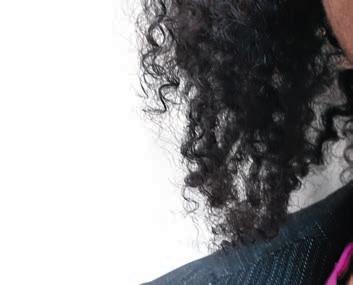
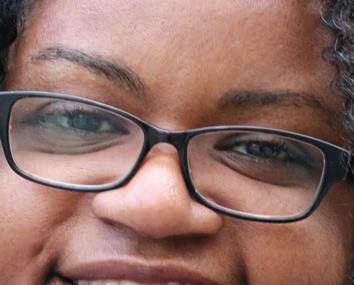



Amy Eusebio, una dominicana negra y directora ejecutiva de la Ofi cina de Asuntos de Inmigración. Foto cortesía de Amy Eusebio/Ofi cina de Asuntos de Inmigrantes.
ognition during this month, while very signifi cant, they do not represent the entirety of the African diaspora and historical context of this country’s Black history.
Whether it’s in the fi eld of art, like Jean-Michel Basquiat or Clara Ledesma; music, like Celia Cruz or Sammy Davis, Jr.; media, like Gwen Ifi ll or Soledad O’Brien; sports, like Roberto Clemente or Pele; or activism, like Arturo Alfonso Schomburg or Maria Elena Moyano, the presence and impact of Afro-Latinidad are alive in just about every facet of life.
THE SIGNIFICANCE OF SCHOMBURG
Another one of the most prominent Afro-Latinos throughout U.S. history is Arturo A. Schomburg, a historian, writer, activist and scholar from the Harlem Renaissance period.
He is the namesake of the Schomburg Center for Research in Black Culture in New York City, one of the world’s leading research libraries devoted exclusively to documenting the history and cultural development of peoples of African descent worldwide.
A Puerto Rican of African and German descent, Schomburg became determined to fi nd and document the accomplishments of Africans after one of his grade school teachers told him that Africans had no history, heroes or accomplishments.
Here in Philadelphia, Taller Puertorriqueño will honor Schomburg and his work by hosting its annual Arturo A. Schomburg Symposium event later this month.
Started in 1997 by a group of Afro-Latinos, the Schomburg Symposium is an annual event that explores the complex relationship between and the intersection of the African Diaspora and Latinx cultures.
“There was no ongoing setting or space where these conversations were happening on a regular basis,” said Carmen Febo San Miguel, executive director of Taller Puertorriqueño King, Rosa Parks, Frederick Douglass, Harriet Tubman y muchos otros son reconocidos durante este mes, ellos no representan a la diáspora africana y contexto histórico completo de la historia afroamericana del país.
Ya sea en el campo del arte, como Jean-Michel Basquiat o Clara Ledesma; la música, como Celia Cruz o Sammy Davis, Jr.; los medios, como Gwen Ifi ll o Soledad O’Brien; los deportes, como Roberto Clemente o Pelé; o el activismo, como Arturo Alfonso Schomburg o Maria Elena Moyano, la presencia e impacto de la afrolatinidad vive en todas las facetas de la vida.
LA IMPORTANCIA DE SCHOMBURG
Otro de los afrolatinos más importantes a lo largo de la historia estadounidense es Arturo A. Schomburg, historiador, escritor, activista y erudito de la época del Renacimiento de Harlem.
Por él lleva su nombre el Schomburg Center for Research in Black Culture (Centro Schomburg para la investigación de la cultura afroamericana) en la ciudad de Nueva York, una de las bibliotecas de investigación líder del mundo dedicada exclusivamente a la documentación de la historia y desarrollo cultural de las personas de ascendencia africana en todo el mundo.
Schomburg, puertorriqueño de ascendencia africana y alemana, decidió encontrar y documentar los logros de los africanos luego que uno de sus maestros de la escuela le dijera que los africanos no tenían historia, héroes o logros.
Aquí en Filadelfi a, el Taller Puertorriqueño hará honor a Schomburg y su trabajo al auspiciar su simposio anual titulado “Arturo A. Schomburg Symposium, más adelante durante este mes.
El Schomburg Symposium, iniciado por un grupo de afrolatinos en 1997, es un evento anual que explora la relación compleja entre y la intersección de la Diáspora africana y las culturas latinas.
Bene't Morando, of African American, Mexican and Sicilian descent (left), at recent graduation from Peirce College.. Photo Courtesy of Bene't Morando.
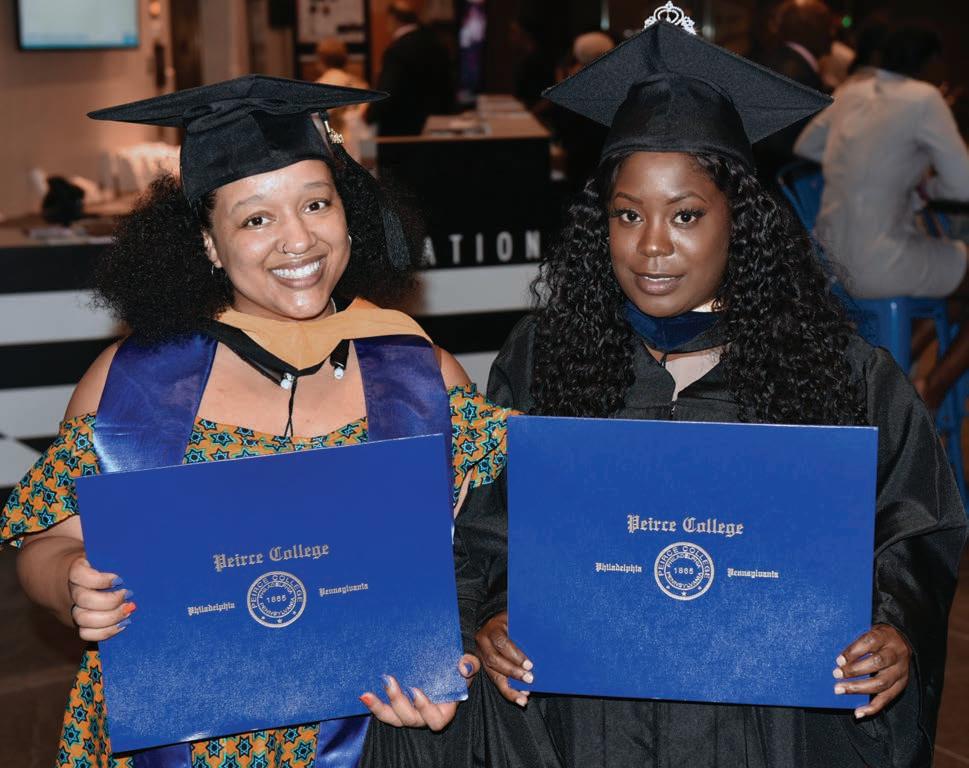
Bene't Morando, de ascendencia afroamericana, mexicana y siciliana (izquierda), en su reciente graduación del Pierce College. Foto cortesía de Bene't Morando.
ENGLISH
and member of the Schomburg Symposium organization committee.
Featuring a number of presentations by distinguished scholars, this event offers the opportunity for attendees to deepen their knowledge and understanding of the African Diaspora in the Americas and foster dialogue between the audience and speakers.
Each year, Taller chooses a theme for the event. This year’s theme is “Afro-Latinx Struggles: Pushing Boundaries Through Engagement.”
San Miguel noted that the struggles that exist for Afro-Latinx communities are vast.
“There are issues that involve representation in media, for example; ignoring the realities of Afro-Latins in reporting stories; there’s issues of artistic representation; there’s issues of violence both against women — not only because of being women but because of being nonwhite — and there’s violence against people of other races,” she added.
“You name it, there are plenty of issues and plenty of activism that has already happened in response to them, but it needs to continue to happen to continue to push society to deal with them,” she added.
The 24th annual Schomburg Symposium will take place on Saturday, Feb. 29 at Taller Puertorriqueño from 9:30am to 5pm.
FACES OF AFRO-LATINX
Philadelphia is home to a diverse set of people — including those who identify as Afro-Latinx.
To obtain a clearer view of Afro-Latinidad in Philadelphia, AL DÍA reached out to a few individuals in the area who identify as Afro-Latinx, and asked questions about their identity, experiences, and thoughts about Black History Month as it pertains to the Afro-Latinx community. The two featured here are Amy Eusebio, executive director of the Office of Immigrant Affairs, and Bene’t Morando, tech ops analyst at JPMorgan Chase — two Afro-Latinas with different experiences, and distinct backgrounds and paths to get to this point of owning and embracing their Afro-Latinidad.
ESPAÑOL
“No existía un escenario o espacio continuo en donde se dieran estas conversaciones con regularidad”, dijo Carmen Febo San Miguel, directora ejecutiva del Taller Puertorriqueño y miembro del comité organizador del Schomburg Symposium.
El evento, que contará con varias presentaciones por parte de eruditos distinguidos, ofrecerá a los asistentes la oportunidad de profundizar en su conocimiento y entendimiento de la Diáspora africana en las Américas y promover el diálogo entre el público y los conferencistas.
Cada año, el Taller elige un tema para el evento. El de este año es “Afro-Latinx Struggles: Pushing Boundaries Through Engagement.” (Las luchas afrolatinas: superar las barreras a través de la participación).
San Miguel señaló que las dificultades que tienen las comunidades afrolatinas son inmensas. “Hay problemas que involu
cran la representación en los medios, por ejemplo; ignorar las realidades de los afrolatinos al reportar sobre las historias; hay problemas en cuanto a la representación artística; problemas de violencia tanto contra la mujer, no sólo por ser mujeres sino porque no son blancas, y violencia contra las personas de otras razas”, agregó.
“Para cualquier asunto existen muchos problemas y mucho activismo que ya se ha dado como respuesta a los mismos, pero necesita continuar para seguir presionando a la sociedad a que los aborde”, concluyó.
El vigésimo cuarto Schomburg Symposium anual se llevará a cabo el sábado, 29 de febrero en el Taller Puertorriqueño, de 9:30 a 17:00 horas.
ROSTROS AFROLATINOS
Filadelfia es el hogar de un grupo diverso de personas, incluso para quienes se identifican como afrolatinos.
Para tener una perspectiva más clara de la afrolatinidad en Filadelfia, AL DÍA se acercó a varias personas en el área quienes se identifican como afrolatinos, y les planteó preguntas sobre su identidad, experiencias y pensamientos sobre el mes de la historia afroamericana. Las dos historias que aquí presentamos son las de Amy Eusebio, Directora ejecutiva de la Oficina de Asuntos de Inmigrantes, y Bene’t Morando, analista de operaciones técnicas en JPMorgan Chase, dos afrolatinas con diferentes experiencias, distintos orígenes y caminos para llegar a este punto de apropiarse de y acoger su afrolatinidad.
ORÍGENES, Y EXPERIENCIAS TEMPRANAS
Eusebio nació en Jersey City, NJ, de padres dominicanos, en una ciudad que describe como “una Meca de diversidad” en que la gente de todas las razas vivía en cada área de la ciudad. Su vecindario estaba lleno, principalmente, de blancos, negros y filipinos. Durante su infancia con frecuencia se identificaba como “una persona negra que hablaba español”, sin jamás tener una conversación explícita sobre la diversidad que existía dentro de la comunidad latina. No fue hasta que llegó a Filadelfia, para hacer sus estudios universitarios, que tomó consciencia sobre ese legado.
Originalmente de Virginia Beach, la madre de Morando era afroamericana y su padre biológico era mexicano “con un toque de siciliano”. Mientras vivió en California, encontró que muchas de las otras niñas la llamaban “negra”, sin pensar en una connotación negativa. Pensaba que era sólo un apodo genial, hasta que su madre le explicó el significado de la palabra en inglés y que se utilizaba de una manera para denigrarla ya que ella tenía un tono de piel un poco más oscura que ellas. Su llegada a Filadelfia le “abrió un mundo completamente diferente”. Fue en la Ciudad del amor fraterno que
BACKGROUND, AND EARLY EXPERIENCES
Eusebio was born in Jersey City, NJ, to Dominican parents — a city she describes as “like a Mecca of diversity,” where people of all races lived in every area of the city. Her neighborhood was filled primarily with blacks, whites and Filipinos. Growing up, she often self-identified as “a black person who spoke Spanish,” without ever having an explicit conversation about the diversity that exists within the Latino community. It wasn’t until she arrived to Philadelphia for college that she became more critically conscious of that heritage.
Originally from Virginia Beach, Morando’s mother is African American and her biological father is Mexican “with a sprinkle of Sicilian.” While living in California, she experienced many of the other little girls calling her “negra,” not knowing of negative connotation. She thought it was just a cool nickname, until her mother explained what the word meant in English and that it was used as a way to belittle her due to the fact that she was a slightly darker shade than they were. Her arrival to Philadelphia, “opened up a whole different world.” It was in the City of Brotherly Love and Sisterly Affection that she noticed the ordeals that often come along with race and ethnicity.
ENGLISH
CHECKING THE BOX With 2020 being a U.S. Census year, the discussion about the imprecise categories of race and ethnicity has come to the forefront. The process of looking at a race/ethnicity question and being unsure what box to check can trigger a discussion. Eusebio and Moranda are representative of the nuances that go along with “checking the box.”
“Last time I filled out the Census, I explicitly checked off ‘Black, Hispanic’ because that’s what I can claim. The boxes don’t feel like they apply when we move from one country to another, like you have to reconstruct how we identify because we’re put into a new context with new boxes that don’t feel like they fit,” Eusebio said.
Morando acknowledged a similar uncertainty when she responds to the census or other official forms.
“Recently, I started doing ”Other” or not identifying at all, because when I get to the point... I recently just started like making it known and not identifying specifically because I don't want to feel like I have to choose because I shouldn't have to,” she said.
REPRESENTATION MATTERS
Growing up, neither Eusebio nor Morando can recall seeing women or people who looked like them in the mainstream. In terms of heritage, background, skin color and hair type, both struggled to find a reflection of themselves. A lack of representation at an early age can turn into denial and non-recognition of the true essence of an individual’s identity. That can follow them throughout their higher education, and professionally. Now adults in the workplace, each woman makes it a point of emphasis on embracing their true identity and helping others do the same.
The intersection of Afro-Latinidad and gender is also important to each, as Afro-Latina leaders in the public sphere.
“As a woman, especially as a Dominican woman, where Dominicans have very clear definitions of beauty for women — which is straight hair, certain features — that self-hate runs deep and it manifests very differently for women,” noted Eusebio.
“The fact that I am Black and that I own my Blackness has been incredibly helpful in my relationship building, for folks to be seen by the Office of Immigrant Affairs,” she added.
Morando focuses on using her position to elevate women of all underrepresented races and ethnicities.
“I see a lot more black women now in the workplace. Curly hair, straight hair, all types. But now, I want to see more Hispanic women in my workplace. A lot of Hispanic women that I run into are cleaning bathrooms and stuff. It’s nothing wrong with that, it’s just I feel like if I’m going to represent for both sides, I want to see both sides of women. I want to do everything I can to make sure both
Como mujer, especialmente como mujer dominicana, donde los dominicanos tienen definiciones muy claras de la belleza para las mujeres. As a woman, especially as a Dominican woman, where Dominicans have very clear definitions of beauty for women.
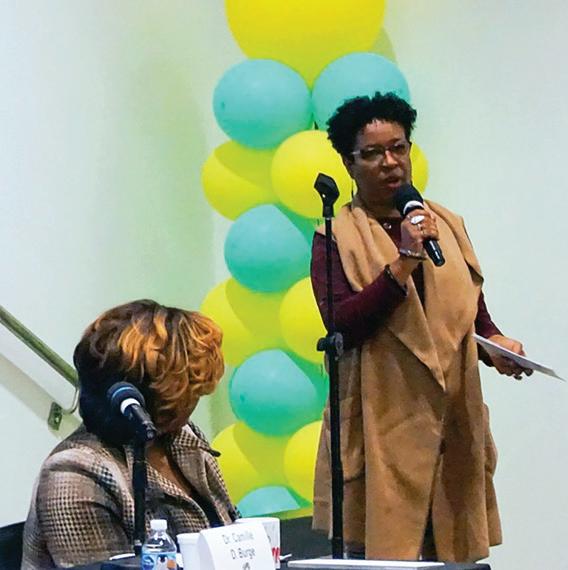
Discussions take place during an annual Schomburg Symposium event. Photo Courtesy of Carmen Febo San Miguel/Taller Puertorriqeuño.
Los debates tienen lugar durante un evento anual del Simposio Schomburg. Foto cortesía de Carmen Febo San Miguel/Taller Puertorriqueño.
ESPAÑOL
ella se percató del sufrimiento que surgía de la mano de la raza y la etnicidad. mente porque no quiero sentir que tengo que elegir, porque no debería tener que hacerlo”, dijo.
MARCA LA CASILLA Como año del censo en los EE.UU., el 2020 trae la conversación sobre las categorías poco precisas de raza y etnicidad al frente. El proceso de observar una pregunta sobre raza/etnia y sentir inseguridad respecto a qué casilla se debe marcar puede iniciar una conversación. Eusebio y Moranda representan los matices de ese acto de “marcar la casilla”.
“La última vez que llené el censo, explícitamente marqué “negra, hispana”, porque eso es lo que puedo afirmar. Las casillas no parecen aplicar cuando nos trasladamos de un país a otro; es como si tuviéramos que reconstruir la forma en que nos identificamos porque nos encontramos en un nuevo contexto con nuevas casillas que no parecen encajar”, dijo Eusebio.
Morando reconoció tener una incertidumbre similar al llenar el censo y otros formularios oficiales.
“Recientemente empecé a marcar ‘Otro’ o no marcar nada, porque cuando llego al punto… recién empecé a darlo a conocer y a no identificarme específica
LA REPRESENTACIÓN IMPORTA
Mientras crecían, ni Eusebio ni Morando recuerdan ver mujeres o personas que se parecieran a ellas en las tendencias dominantes. En cuanto a herencia, orígenes, color de piel y tipo de cabello, ambas tuvieron dificultades encontrando un reflejo de sí mismas. La falta de representación a una edad temprana puede convertirse en negación o falta de reconocimiento de la verdadera esencia de identidad de un individuo; algo que los puede acompañar a lo largo de su carrera de estudios superiores, y en el campo profesional. Ahora ya adultas en el lugar de trabajo, cada una de estas mujeres recalca la importancia de adoptar su verdadera identidad y ayudar a otros a que hagan lo mismo.
La intersección de la afrolatinidad y el género también es importante para ellas, como líderes afrolatinas en su espacio público. “Como mujer, en especial como mujer dominicana, ya que los dominicanos tienen definiciones muy claras de belleza para las mujeres, pelo lacio, ciertas características; ese desprecio pro
Uno de los afro-latinos más prominentes a lo largo de la historia de los Estados Unidos fue Arturo A. Schomburg, un historiador, escritor, activista y académico del período del Renacimiento de Harlem. One of the most prominent Afro-Latinos throughout U.S. history is Arturo A. Schomburg, a historian, writer, activist and scholar from the Harlem Renaissance period.
ENGLISH
sides are able to leverage me and get to a point where they are edifying their family, their lineage and everything that comes behind it,” she said.
BLACK HISTORY IS AMERICAN HISTORY, AND INCLUDES AFRO-LATINOS
The Black community is rich and diverse in terms of both culture and history, and the celebration of Black History Month should be a celebration of all that richness and diversity. This is best done through education.
Morando said that Black History Month isn’t “promoted enough,” but the heritage of African ancestry, culture, and history is something that should be embraced.
“I think Black History Month is about celebrating the fact of overcoming and how much has been accomplished, but has not been taught,” she said. “I feel empowered celebrating Black History month because that’s part of my history and it’s part of American history, so people shouldn’t disregard it.”
Eusebio agreed that “there is power in being seen.”
“A lot of the issues that Latinos struggle with in the U.S., other than things related to immigration, it’s really issues of poverty. And if we can get over identity politics and see ourselves in one another, I think that’s immensely powerful. And that part of that I think is owning your Blackness,” she said. “There’s so much power in storytelling, knowing your story, your history, but sharing your story — spaces where people can elevate those stories and have it at the front of people’s minds versus an afterthought,” Eusebio added.
It comes back to recognizing the multiple narratives, journeys, and identities that form part of the Black community and experience, as well as the history of the U.S. as a whole.
The celebration of Black History Month is a celebration of not only the Black community, but the communities within the Black community. It’s a celebration of not only Black history, but American history. There is not one specific group of people that should get more recognition than another when it comes to celebrating this month. However, the truth is that it’s also a reality that can’t be told with a small handful of names. It’s best told through hours of research, reading, dialogue and discussion.
Colorism among the Black and Latinx communities is one of the topics that was discussed. hoto Courtesy of Carmen Febo San Miguel/Taller Puertorriqueño.
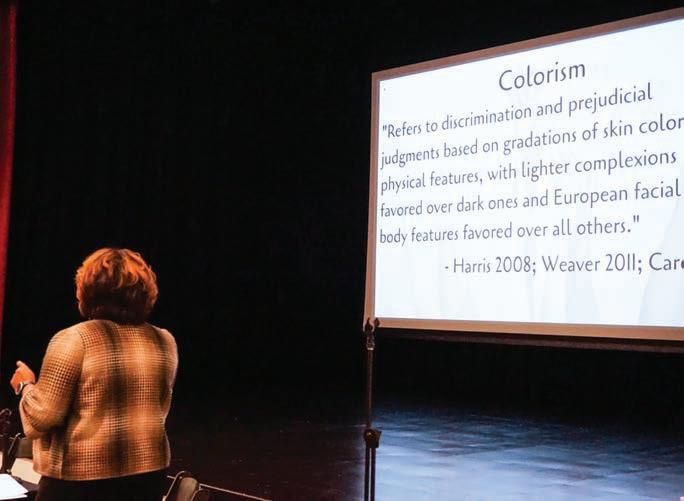
El colorismo entre las comunidades negra y latina es uno de los temas que se discutieron. Foto cortesía de Carmen Febo San Miguel/Taller Puertorriqueño.
ESPAÑOL
pio es profundo y se manifiesta de formas muy diferentes para las mujeres”, señaló Eusebio. “El hecho de que yo sea negra y que me apropiara de mi negrura me ha ayudado mucho a establecer mis relaciones, para que la gente sea vista por parte de la Oficina de asuntos de inmigrantes”, agregó.
Morando se enfoca en utilizar su puesto para elevar a las mujeres en todas las razas y etnias subrepresentadas.
“Ahora veo muchas más mujeres negras en el lugar de trabajo. Cabello rizado, cabello lacio, de todos tipos. Pero ahora, quiero ver a más mujeres hispanas en mi lugar de trabajo. Muchas mujeres hispanas con las que me topo están limpiando
los baños y cosas así. No hay nada malo con eso, es sólo que siento que si voy a representar a ambos lados, quiero ver los dos lados de las mujeres. Quiero hacer todo lo que pueda por asegurar que los dos lados puedan potencializarse y llegar al punto en el que estén edificando a sus familias, su linaje y todo lo que existe detrás de ello”, dijo.
LA HISTORIA AFROAMERICANA ES LA HISTORIA ESTADOUNIDENSE, E INCLUYE A LOS AFROLATINOS
La comunidad afroamericana es rica y diversa tanto en cuanto a su cultura como su historia, y la celebración del Mes de la historia afroamericana debe ser una celebración de toda esa riqueza y diversidad. Esto se logra de la forma más óptima a través de la educación.
Morando dijo que el Mes de la historia afroamericana no “se promueve lo suficiente” pero la herencia de la ascendencia, cultura e historia africana es algo que se debe acoger.
“Creo que el Mes de la historia afroamericana trata sobre celebrar el hecho de superar y cuánto se ha logrado, pero no se ha enseñado”, dijo. “Me siento empoderada al celebrar el mes de la Historia afroamericana porque esa es parte de mi historia y es parte de la historia estadounidense, por lo que la gente no lo debe menospreciar”.
Eusebio coincidió en cuanto a que “hay poder en ser visto”.
“Muchos de los problemas que enfrentan los latinos en los EE.UU., aparte de aquello relacionado con la inmigración, son realmente problemas de pobreza. Y si podemos sobrepasar la política de la identidad y vernos los unos en los otros, creo que eso es muy poderoso. Y que parte de eso es acoger nuestra negrura”, dijo Morando.
“Hay tanto poder en contar historias, conocer nuestra historia, nuestro pasado, compartir nuestra historia; los espacios en los que la gente puede elevar esas historias y situarlas en primer plano en la mente de la gente en vez de como un idea tardía”, agregó Eusebio.
Nos trae de vuelta a reconocer las narrativas, trayectorias, e identidades múltiples que forman parte de la comunidad y la experiencia afroamericana, así como la historia de los EE.UU. en su conjunto.
La celebración del Mes de la historia afroamericana es una celebración no sólo de la comunidad afroamericana, sino de las comunidades dentro de la comunidad afroamericana. Es una celebración no sólo de la historia afroamericana, sino de la historia estadounidense. No existe un grupo específico de personas que deba obtener más reconocimiento que otro cuando se trata de celebrar este mes. Sin embargo, la verdad es que también es una realidad que no puede ser relatada con un puñado de nombres. Se narra mejor a través de largas horas de investigación, lectura, diálogo y conversación.
CULTURA
“RUNWAY ON THE RUNWAY” AT JFK AIRPORT SETS A NEW FASHION SHOW STANDARD Jessica Minh Anh adds DHL into her Fashion x Sustainability series. Photo: Press material
" PASARELA EN LA PISTA" EN EL AEROPUERTO JFK ESTABLECE UN NUEVO ESTÁNDAR DE DESFILE DE MODA Jessica Minh Anh añade DHL a su serie Fashion x Sustainability. Foto: Material de prensa
TACKLING CLIMATE CHANGE WITH FLAIR

"RUNWAY ON THE RUNWAY" TRANSFORMED THE JFK AIRPORT IN NY INTO A SUSTAINABLE FASHION DISPLAY. “RUNWAY ON THE RUNWAY” TRANSFORMA EL AEROPUERTO JFK EN NY EN UN DESPLIEGUE DE MODA SOSTENIBLE.
Jessica Minh Anh is a Vietnamese supermodel who is innovating the world of haute couture fashion shows: she visits iconic places and mounts impressive catwalks in which all the elements involved are directly linked to sustainability. On Feb. 6, one of the runways at New York City's John F. Kennedy Airport was taken over exhibiting pieces by two Latina designers: Ani Alvarez Calderon of Peru and Cristina Sabatini of Brazil.
ENGLISH ESPAÑOL
This monumental show was part of the opening of New York's Fashion Week, and it was intended to leave a lasting impression on the entire industry.
The Runway on the Runway is the continuation of ten years of interventions by Jessica Minh Anh on the subject of climate change.
Jessica Minh Anh es una súper modelo vietnamita que está innovando el mundo de los desfiles de alta costura: interviene lugares icónicos y monta en ellos impresionantes pasarelas en las que todos los elementos involucrados están directamente vinculados con la sostenibilidad. El 6 de febrero se tomó una de las pistas de aterrizaje del aeropuerto John F. Kennedy de la ciudad de Nueva York exhibiendo piezas de dos diseñadoras latinas: Ani Álvarez Calderón, de Perú, y Cristina Sabatini, de Brasil.
Este desfile monumental fue en el marco de la apertura de la semana de la moda en Nueva York, con lo que buscaba dejar una huella duradera en la industria entera.
Esta pasarela en la pista (Runway on the Runway) es la continuación de diez años de intervenciones hechas por Jessica Minh Anh entorno al tema del cambio climático, “lo que estoy haciendo es tratar de enviar un mensaje sobre la sostenibilidad de una manera más creativa y visualmente atractiva”, dice Minh Anh.
Ani Álvarez Calderón nació en Lima, Perú, y luego de trabajar con Michael Kors y comercializar sus diseños para algunas clientes particulares, empezó su marca personal en el año 2000. Sus diseños frecuentemente reinterpretan las tradiciones y el paisaje peruano, representados en la paleta de colores que elige, el tipo de tejidos e incluso algunos cortes.
“Yo considero la alta costura como un arte donde te puedes dar el gusto de soñar y crear piezas que sean atemporales y muy creativas. Que sean hechas a mano y un buen medio para contar una historia”. Mientras muchas de sus piezas han estado enfocadas exclusivamente para la pasarela, ahora se está concentrando mucho
“RUNWAY ON THE RUNWAY” AT JFK AIRPORT SETS A NEW FASHION SHOW STANDARD Jessica Minh Anh adds DHL into her Fashion x Sustainability series. Photo: Press material
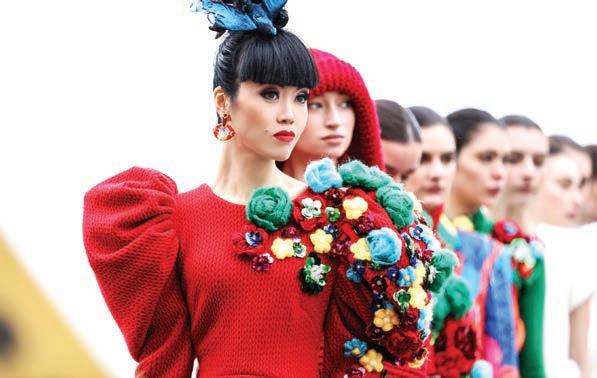
" PASARELA EN LA PISTA" EN EL AEROPUERTO JFK ESTABLECE UN NUEVO ESTÁNDAR DE DESFILE DE MODA Jessica Minh Anh añade DHL a su serie Fashion x Sustainability. Foto: Material de prensa
“What I'm doing is trying to send a message about sustainability in a more creative and visually appealing way," says Minh Anh.
Ani Alvarez Calderon was born in Lima, Peru, and after working with Michael Kors and selling her designs to some private clients, she started her personal brand in 2000. Her designs often reinterpret Peruvian traditions and landscape, represented in the color palette she chooses, the types of fabrics and even some fabric cuts.
"I consider haute couture as an art where you can indulge in dreams and create pieces that are timeless and very creative, that are handmade and a good way to tell a story,” Alvarez Calderon says.
While many of her pieces have been focused exclusively on the runway, she is now focusing much more on functionality.
"Haute couture is the opposite of fast fashion, which is what pollutes the world the most," the designer noted, explaining the pieces she prepared for this show. "For this collection I'm presenting in New York, I decided to reinterpret and reuse my iconical pieces that I designed in the last 15 years and present them in a new way."
Cristina Sabatini is Brazilian and designed part of the jew
ENGLISH
elry that will be exhibited at the event. She finds that in the case of jewelry the search for sustainability is more complex, since it is a sector of the industry with a high dependence on raw materials, although efforts are being made to change that.
"I see companies starting to source responsibly, to use recycled metals and materials, and to think about how logistics impact on the environment, and all of this is inspiring to see the steps we are taking to save our planet,” Sabatini says.
She sees that jewelry has a greater potential to be sustainable in the way it is produced and worn, since some pieces could be worn every day for years.
"Part of sustainability begins with our innate desire to participate in it, which translates into less consumption, and that's very difficult in the fashion industry,” she says. “I hope that wearers love my jewelry enough to want to wear it every time, instead of going out and buying another item that can only be worn once.” All this was done in partnership with DHL, which since 2007 has reduced its carbon dioxide emissions at all levels of its supply chain: routes, low impact transport in the first and last mile of the supply chain and has funded carbon dioxide offset projects across the globe.
Parte de la sostenibilidad comienza con nuestro deseo innato por participar en ella. Haute couture is the opposite of fast fashion, which is what pollutes the world the most.
ESPAÑOL
más en su funcionalidad, según comenta.
“La alta costura es el opuesto al fast fashion, que es lo que más contamina el mundo”, dice Ani Álvarez Calderón, explicando las piezas que preparó para este desfile.
“Para esta colección que voy a presentar en Nueva York decidí reinterpretar y reusar mis piezas icónicas que diseñé en los últimos 15 años y presentarlas de una nueva manera”.
Cristina Sabatini es brasilera y diseñó parte de las joyas que serán exhibidas en el evento. Ella encuentra que en el caso de la joyería la búsqueda por la sostenibilidad es más compleja, dado que es un sector de la industria con una alta dependencia de las materias primas, aunque se estén haciendo esfuerzos en ese sentido.
“Veo empresas que empiezan a abastecerse de manera responsable, a utilizar metales y materiales reciclados, y a pensar en cómo la logística impacta en el medio ambiente, y todo ello es inspirador para ver los pasos que damos para salvar nuestro planeta”. Ella ve que la joyería tiene un mayor potencial para ser sostenible en la intención con que se produce y usa, en ser llevada a diario durante años. “Parte de la sostenibilidad comienza con nuestro deseo innato por participar en ella, lo que se traduce en un menor consumo y eso es muy difícil en la industria de la moda. […] Espero que los usuarios amen mis joyas lo suficiente como para querer usarlas cada vez, en vez de salir a comprar otro artículo que sólo se puede usar una vez”.
Todo esto se hizo en alianza con DHL, que desde el 2007 ha reducido sus emisiones de dióxido de carbono en todas las instancias de su cadena de trabajo: rutas, medios de transporte con bajo impacto en la primera y última milla de la cadena de distribución y ha financiado proyectos de compensación de dióxido de carbono a lo largo de ancho del orbe.
“RUNWAY ON THE RUNWAY” AT JFK AIRPORT SETS A NEW FASHION SHOW STANDARD Jessica Minh Anh adds DHL into her Fashion x Sustainability series. Photo: Press material

" PASARELA EN LA PISTA" EN EL AEROPUERTO JFK ESTABLECE UN NUEVO ESTÁNDAR DE DESFILE DE MODA Jessica Minh Anh añade DHL a su serie Fashion x Sustainability. Foto: Material de prensa








